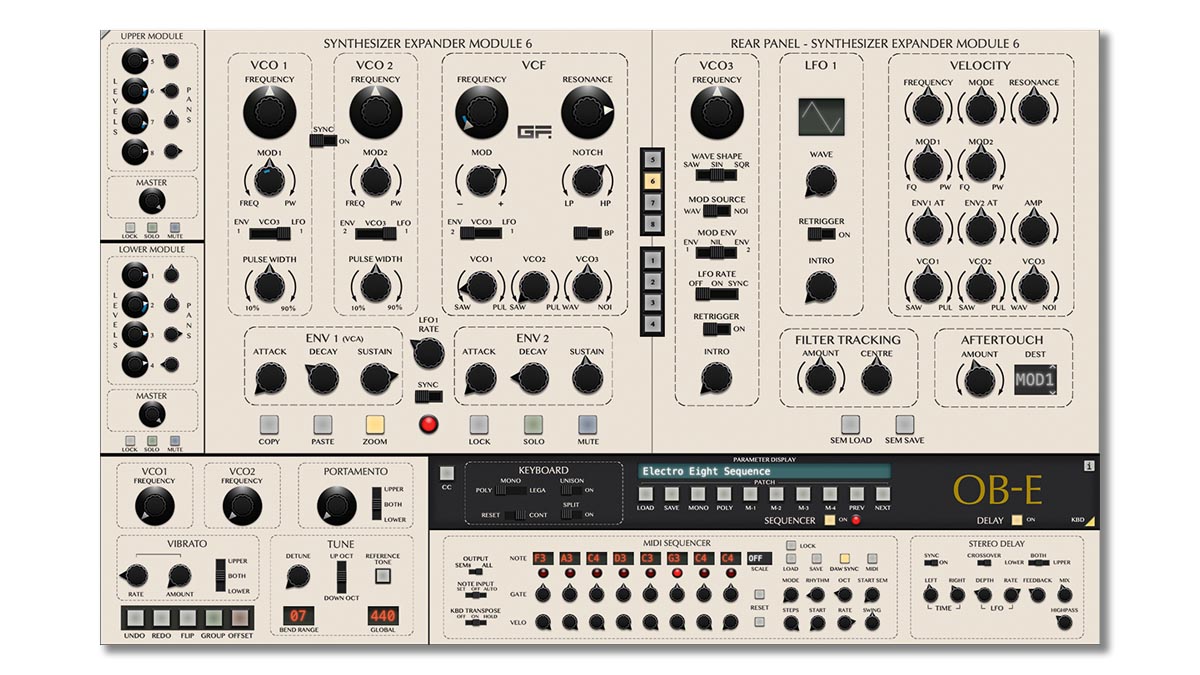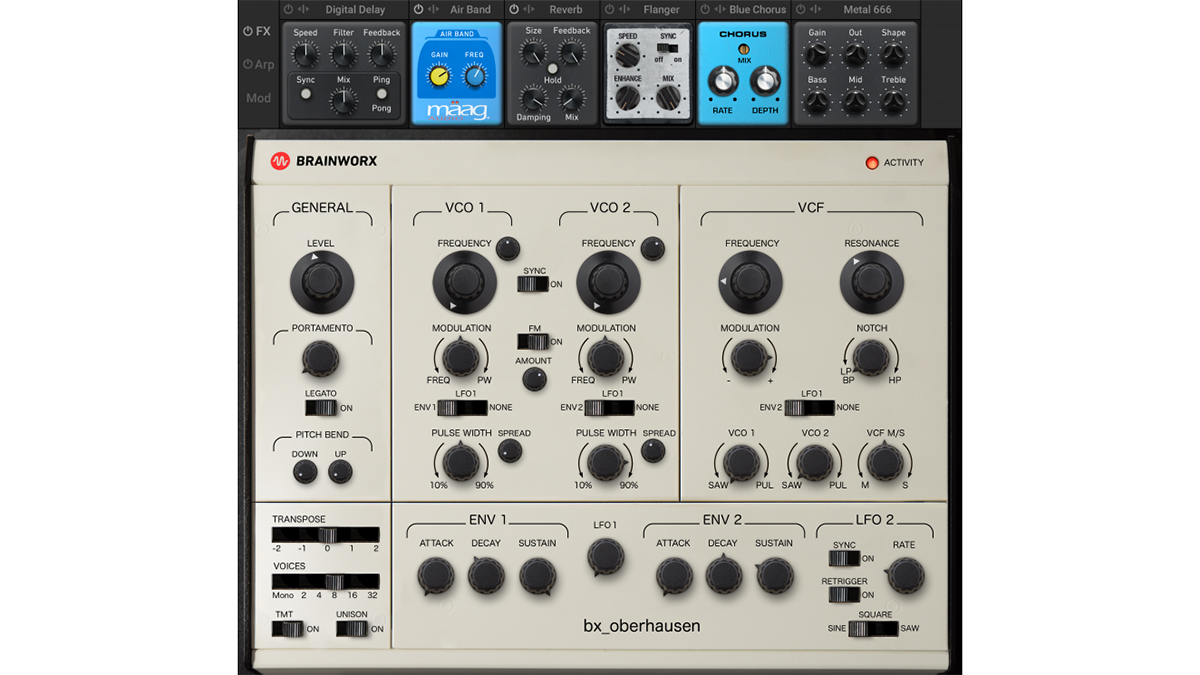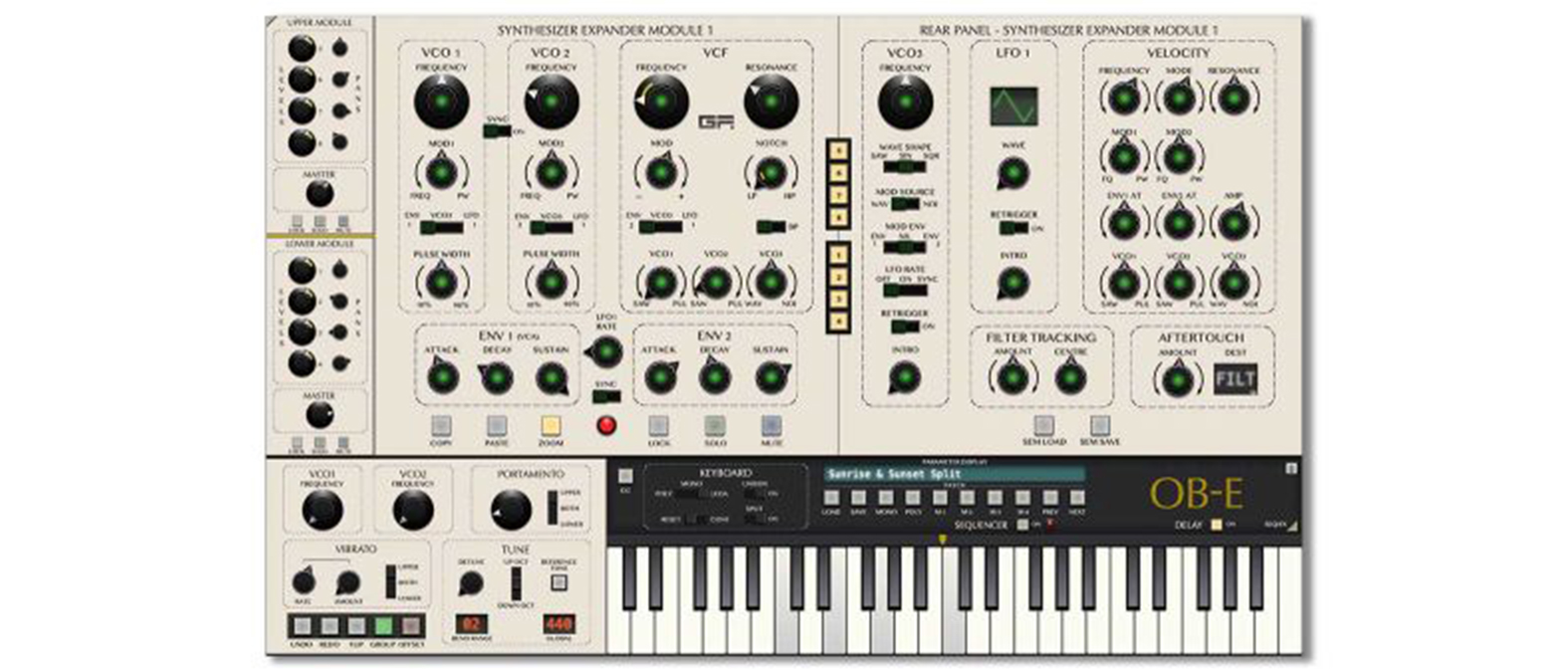MusicRadar Verdict
An impressive emulation, sounds awesome and enhances the original design with fantastic features and efficiencies.
Pros
- +
Faithful emulation.
- +
All eight SEMs on one screen.
- +
Sounds amazing particularly in Unison.
- +
Enhanced yet retro-style sequencer.
- +
Resizable window/SEM zoom options.
- +
Excellent set of 600 factory presets.
Cons
- -
No PC version as yet.
MusicRadar's got your back
What is it?
Back in the day and before polysynths became a thing, Oberheim upscaled its SEM (Synthesizer Expander Module) monosynth into a number of multi-module designs. The most ambitious (EVS-1) used eight SEMs and was better known as the 8-Voice.
This delivered 8-note polyphony where each voice was basically a different synth and could therefore create rich polytonal sounds. But things moved on and Oberheim developed a synth (the OB-X) that achieved polyphony in a more efficient fashion.
Thankfully software developer (and proud 8-Voice owner) GForce has finally got round to emulating this complex synth – no mean feat – and OB-E is now available for Mac OS X (AU, VST, AAX, standalone).
Nitty Gritty
OB-E is arranged with all eight SEMs and their outputs and pans simultaneously visible. SEMs are also grouped for the Split keyboard mode – Lower (SEMs 1 to 4) and Upper (SEMs 5 to 8). The bottom section of the window includes the preset browser, global controls such as playback mode, Portamento, Vibrato and global editing options.
On the lower right is a 49-key keyboard and the corner icon switches this to show the MIDI Sequencer and Stereo Delay. SEMs also have more parameters on a Rear Panel view and can be flipped individually or collectively.
A Zoom option places one SEM – front and rear views – across the whole SEM section. There are no further hidden panels, which is great, but the interface is quite busy. Thankfully, the window can be accurately resized to work best with your screen resolution.
Sound Generation
Each SEM has two main oscillators (VCO1 and 2) with either sawtooth or pulse (with adjustable pulse width) and two ADS envelopes. A third oscillator (VCO3) adds sawtooth, sine or square wave shapes and can be used for audio (as a sub-oscillator for example) or as another syncable LFO using either its wave shape or pink noise.
The 12dB/octave filter is based on both GForce’s 8-Voice filter and a modern reissue SEM
Meanwhile, the main syncable LFO (LFO1) has six shapes (including noise) and adjustable onset delay. VCOs 1 and 2 can choose from three hardwired modulators (envelope, LFO1 and VCO3) and these can modulate either pitch or pulse width (if used). Each SEM also has dedicated controls to assign velocity to up to 11 parameters and aftertouch to up to five parameters. For ease of use, target controls are colour coded and it’s good to see plenty of aftertouch assignments in the presets.
The 12dB/octave filter is based on both GForce’s 8-Voice filter and a modern reissue SEM. In addition to cutoff, resonance and modulation (ENV2, VCO3 and LFO1) you have a knob to adjust smoothly between low-pass, notch and high-pass. A further switch selects a dedicated band-pass mode. At the bottom, you balance the VCO levels into the filter.
Double Feature

OB-E’s MIDI Sequencer is inspired by Oberheim’s original add-on eight-step sequencer module (MS-1) and to be true to the original, OB-E’s SEM 8 Output mode uses the eighth SEM for your sequence, leaving the remaining SEMs to play live.
However, far more interesting is All mode, which, if used in conjunction with the Cont playback setting, activates all eight SEMs in order, one-SEM-per-sequence step. Whichever Output mode you use, each sequence step has a dedicated Gate and Velocity setting, and there are five overall sequence styles (Modes) including a chord option.
There are a few ways to input sequence notes, including manually and via MIDI. You can also control the sequence starting pitch using a DAW MIDI part or drag the MIDI for the sequence from OB-E back into your DAW.
Further overall sequence options include Swing, Rate, Octave, number of Steps, Start step and Start SEM. Finally, the Rhythm knob selects one of 14 presets (these affect the Velocity and Swing settings). So still very much a programmable analogue-style sequencer, but one designed to showcase the eight-SEM design. If we have one gripe, it’s simply that you can’t zoom the sequencer window.
Performance and verdict
Conjuring some rich fuzziness from one of OB-E’s SEMs is pretty easy. But what we’re really interested in is how those eight SEMs work together.
To GForce’s credit, OB-E is still very much led by the original 8-note polyphony limit, but you have a variety of ways to use it. First up, successive notes can either Reset or move through (Continuous) the SEMs, and this ties in with the chosen playback mode (Mono, Poly or Legato). So, in Poly mode with Cont selected each time you play a three-note chord it shifts three SEMs along.
Unison mode, much like the original 8-Voice unison, plays all SEMs together and on OB-E, one MIDI note puts 24 oscillators at your disposal, so you can build massive chords across the eight SEMs. Finally, Split mode adds an adjustable key split with four SEMs per split.
The massive sonic potential could require quite a bit of knob twiddling, but thankfully you have many efficiencies including SEM-specific copy, paste, solo, mute, save and load as well as global editing (Group and Offset). All this makes OB-E easy to program.

• Brainworx bx_oberhausen
TMT modelling, 32-note polyphony and a powerful unison mode deliver great sonic flexibility.
• Arturia Oberheim SEM V
Arturia’s SEM-inspired synth includes an 8-voice programmer to help emulate the multi-voice sound.
OB-E has dedicated Mono and Poly starter patches, but for a quick fix head straight for the 600 categorised factory presets. The Alpha Patches showcase 30 of the best presets and beyond this, basic folders (Bass and Effects) give way to type-driven categories (Mono, Poly Pad, Sequence Poly, Unison Chord and so on).
Among these, OB-E delivers characterful basses, great mono leads and honest, straight-up pads. However, we are fundamentally drawn to the big track-filling patches, as these are what set OB-E apart from other synths.
From the Unison folders, many patches deliver harmonically rich sounds from the Holdsworth-like Epiphany with Inversion 01 to the portamento beauty of Ice Cold From Alex 01. For sheer fatness, Unison Sync is hard to beat and there are also some great splits (Triumphant Unison Split). GForce has always developed software versions of the synths they like and, in that respect, OB-E is no exception.
However, the 8-Voice is itself a truly exceptional synth and OB-E a particularly good emulation that not only does justice to the original sound but also enhances it in ways that are both useful and sympathetic to the original. We would love to see a PC version, but it’s full marks from us nonetheless.
MusicRadar verdict: An impressive emulation, sounds awesome and enhances the original design with fantastic features and efficiencies.
The web says
“OB-E is, quite simply, brilliant. The emulated analogue filters are rich and smooth, and the oscillators are fat and punchy. Critically, the performance controls and ease of programming make it enormous fun to use. It also makes getting excellent sounds swift and efficient.“
MusicTech
Hands-on demos
GForce Software
Alex Ball
Synth Anatomy
Specifications
- TYPE: Softsynth (AU, VST, AAX, standalone)
- KEY FEATURES: 8-Voice Octaphonic architecture, 600 factory Patches, group mode for multi module editing, zoomable interface, Multiple triggering modes (Polyphonic, Monophonic, Mono Legato, Unison), Polyphonic aftertouch and MPE ready
- SYSTEM REQUIREMENTS: Intel or M1 Mac macOS 10.11.x or above; 30MB of disk space
- CONTACT: GForce Software
Computer Music magazine is the world’s best selling publication dedicated solely to making great music with your Mac or PC computer. Each issue it brings its lucky readers the best in cutting-edge tutorials, need-to-know, expert software reviews and even all the tools you actually need to make great music today, courtesy of our legendary CM Plugin Suite.
"This is the amp that defined what electric guitar sounds like": Universal Audio releases its UAFX Woodrow '55 pedal as a plugin, putting an "American classic" in your DAW
"Yamaha has achieved an extraordinary level of immersiveness and realism, crafting an instrument that sounds closer to an acoustic piano and feels like one under your fingers": Yamaha Clavinova CLP-885 digital piano review
With its latest free update, Ableton has finally turned Note into the app I always wanted it to be











